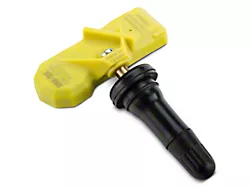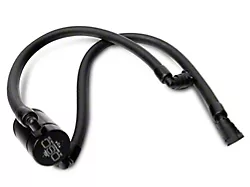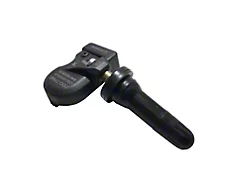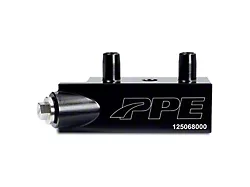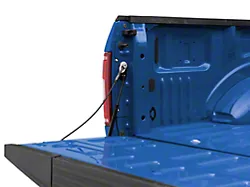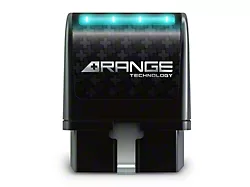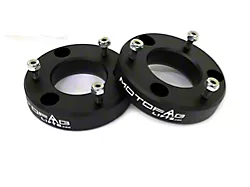
How to Install Rough Country 3.75 in. Suspension & Body Lift Kit on your Sierra
Installation Time
2 hours
Tools Required
- 18mm Wrench
- 15mm Socket
- 15mm Wrench
- 17mm Wrench
- 21mm Wrench
- 7/32 Allen Wrench
- Flat Screwdriver
- Hammer
- Jack
- Jack Stands
- Wood Blocks (2x4)
- Pliers
- Phillips Screwdriver
- Drill Motor
- 1/2” Drill Bit
- Reciprocating Saw
- Clamp
- 8mm Socket
- 10mm Socket / Wrench
- 14mm Socket / Wrench
- 13mm Socket / Wrench
- 15mm Socket / Wrench
- 16mm Socket / Wrench
- 18mm Socket / Wrench
- 19mm Socket / Wrench
- 21mm Socket / Wrench
- 22mm Socket / Wrench
- Hand Grinder
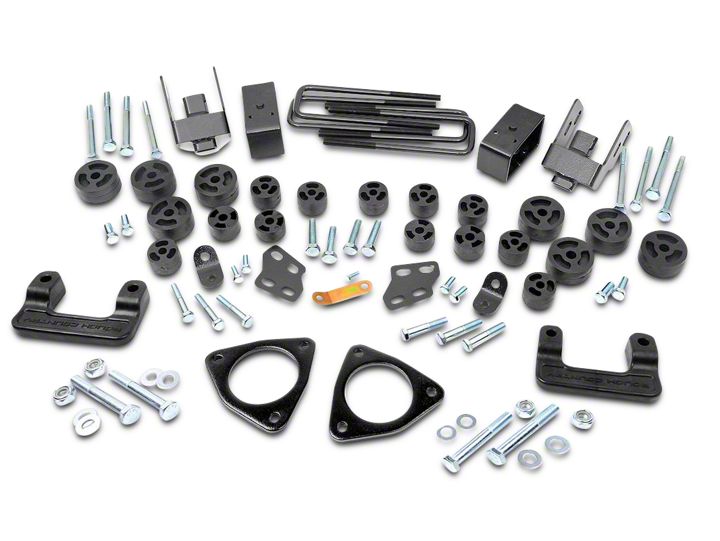
Shop Parts in this Guide
Kit Contents:
2- Lower Strut Extensions
2– Upper strut spacers
2- 2” Rear Blocks
4– 9/16 U-Bolts
1307 Kit Bag
4-10x1.5x80mm bolts
8-SAE Flat washers
4-10mm nuts
9/16 Kit Bag
8– 9/16 nuts
8– 9/16 washers
INSTALLATION INSTRUCTIONS
1. Jack up the front of the vehicle and support the vehicle with jack stands, so that the front wheels are off the ground
2. Remove the front tires/wheels., using a 21mm deep well socket
3. Using a 18mm wrench loosen the upper strut bolts. Do not remove at this time. See Photo 1.

4. Place jack stand under the knuckle for support. Remove upper ball joint nut, using a 18mm wrench. Using a hammer hit the knuckle as shown to allow the ball joint to separate from the knuckle. See Photo 2. Do not allow the
knuckle to pull out far enough that it pulls the shaft out of the differential.
5. Using a 21mm wrench remove the nut from the steering linkage. Using a hammer hit on the side of the knuckle as shown, where the steering linkage is connected and remove from knuckle. Push linkage forward to make room for
installation. Retain factory hardware. See Photo 3.
6. Remove the sway bar nut and bushings using a 15mm wrench, and 15mm socket. Retain factory hardware. See Photo 4

7. Using a 15mm wrench or socket remove the bolts from the bottom strut mount. See Photo 5
8. Remove the bolt clips from the bottom of the strut using a flat screw driver. See Photo 6

9. Using a 18mm wrench, remove strut bolt nuts as shown in Photo 1 on previous page and remove strut from truck.
10. Using supplied plate, install atop of strut as shown. See Photo 7.
11. Now that plate is in place, reinstall strut using factory hardware and hand tighten in place.
12. Press down on lower control arm and place strut spacer under the lower strut mount and align holes. See Photo 8.
13. Install the new 10mm bolts, washers and nuts provided in the kit. Install bolts with the head going down as shown in Photo 9. Tighten to 30-35 ft/lbs. Do not over-tighten the bolts. You may have to move the knuckle to one side to
allow room to install the bolt by the axle shaft.

14. Tighten the bolt using a 17mm wrench, and a 16mm wrench for the nut.
15. Using a 18mm wrench tighten the upper strut nuts, torque to factory specs See Photo 10.
16. Raise the lower control arm and connect the upper ball joint on the upper control arm to the spindle. Using a 18mm wrench, torque to manufacturer specs. If ball joint turns while tightening, use a 7/32”allen wrench to hold the ball joint. See Photo 11 next page.
17. Reinstall the steering linkage nut using a 21mm wrench. If ball joint turns while tightening, use a 10mm wrench to hold the bottom of the tie rod. See Photo 12

18. Repeat steps 3-14 on opposite side of vehicle
19. Using a 15mm wrench, reinstall sway bar bushings and nut using factory hardware. Torque to factory specs.
20. Install the wheels / tires, using a 21mm deep well socket.
18. Jack up the vehicle and remove the jack stands. Lower the vehicle to the floor and torque all bolts to factory specifications.
19. Using an certified alignment professional, have an alignment done to factory specifications.
REAR INSTALLATION
1. Chock the front wheels and jack up the rear of the vehicle. Support the vehicle with jack stands. Remove the tires/wheels using 7/8” deep well socket.
2. Support the rear axle with a floor jack and remove lower shock bolts with a 21mm and then remove the factory u bolts.
4. Remove stock block and install the new 2” block on the axle making sure the block and axle pin align. See Photo 1.
5. Install the supplied 9/16” u-bolts and hardware and secure to the correct factory torque specs. See Photo 2.
7. Install rear shock back into location using a 21mm wrench.

8. Install the wheels and tires. Tighten lug nut to factory specifications using crossing pattern. Lower the vehicle to the ground. Tighten the lug nuts to 85 ft lbs.
POST INSTALLATION
1. Check all fasteners for proper torque. Check to ensure there is adequate clearance between all rotating, mobile, fixed and heated members. Check steering for interference and proper working order. Test brake system.
2. Perform steering sweep. The distance between the tire sidewall and the brake hose must be checked closely. Cycle the steering from full turn to full turn to check for clearance. Failure to perform inspections may result in component failure.
3. Re torque all fasteners after 500 miles. Visually inspect components and re torque fasteners during routine vehicle service.
4. Readjust headlights to proper settings.
MAINTENANCE INFORMATION
It is the ultimate buyers responsibility to have all bolts/nuts checked for tightness after the first 500 miles and then every 1000 miles. Wheel alignment steering system, suspension and driveline systems must be inspected by a qualified professional mechanic at least every 3000 miles.
CAB INSTALLATION INSTRUCTIONS
1. Raise hood disconnect positive and negative battery cable from the battery using 10mm wrench. This is done to prevent accidental airbag deployment. Check owners manual and remove airbag fuses to prevent accidental air bag deployment.
2. Remove the eight plastic clips from the radiator bezel using a screwdriver and remove bezel. Retain hardware for reuse. See Photo 1.
3. Remove 4 bolts from grill using a 10mm socket then pull on lower part of grill to release clips. Retain hardware for reuse. See Photo 2.

4. Remove four of the clips from the rubber shroud that is attach to the bumper. There are 9 clips total but only 4 need to be removed to remove bumper. Retain hardware for reuse.
5. Unplug fog lights on bumper if equipped.
6. Remove the bumper support brackets located near front body mount that attach bumper to frame using a 15mm socket. See Photo 3. Retain hardware for reuse.
7. Remove the two upper bumper bolts using 21mm socket and remove bumper from truck. See Photo 4.

8. Remove ground wire from firewall using 10mm socket. Retain hardware for reuse. See Photo 5.
9. Remove both ground wires from frame located on front body mount using 10mm socket / wrench. Retain hardware for reuse. See Photo 6.

10. Remove upper radiator hose and overflow hose from fan shroud as shown in Photo 7 & 8.

11. Disconnect air intake hose from air box using a Phillips screwdriver and needle nose pliers. See Photo 9.
12. Lock steering wheel and mark the location of the upper and lower parts of steering shaft. Remove the shaft bolt using a 15mm socket. See Photo 10. Do not turn or allow steering to turn while shaft is apart.

13. Remove starter wire and O2 sensor wire from frame on passenger side as shown in Photo 11 using a 13mm wrench and screwdriver or pliers
14. Remove the four bolt securing the skid plate using a 15mm socket. See Photo 12.

15. Disconnect the emergency brake cable at the connection on the frame below the drivers door by removing the front part of cable from frame just under the front part of driver door. See Photo 13 & 14.

16. Loosen all cab bolts on driver and passenger side using a 15mm & 18mm for both front body mounts as shown in Photo 15 and 21mm for the other 6 cab mounting points as shown in Photo 16. Remove body mount hardware one side at a time.

17. Photo 17 will is removing the cab support strap with a 18mm socket, this is only on a standard cab truck. If you have a extended or crew cab truck please skip this step.
18. Using a jack stand or hydraulic jack with wood blocks slowly lift body from truck. See Photo 18.

19. Lift only enough to place body puck on top of body mount. See Photo 19. Note: Passenger side front body mount bolt can be removed by lifting the body bushing out of frame so the bolt will pass by the A/C lines.
20. Apply thread lock to the three supplied 14x 2.0 x 140mm bolts and install for the 3 body mount on pass side. See Photo 20.

21. Apply thread lock to the two supplied 12mmx 1.75 x 140mm bolt and install for the front body mounts. Do not tighten at this time. Note: Install front body mount bolt in same way as it was taken out to clear A/C lines. See Photo 21.
22. Repeat for Drivers side.

23. Tighten all 14mm bolts to 95ft-lbs using 22mm socket and all 12mm to 65ft-lbs using 18mm socket.
24. Check trans lines make sure the are not rubbing A/C compressor bracket or belt tensioner on some models. Bend lines away if necessary. See Photo 22 & 23
25. Reinstall front skid plate with stock hardware and tighten using 15mm socket / wrench to 20 ft-lbs torque.
26. Reconnect engine ground to firewall using supplied ground extension bracket and supplied 1/4” x 3/4” bolt. Tighten with a 11mm socket. See Photo 24.
27. Reconnect both front body mount ground wires as previously removed in stock location using a 10mm socket.
28. Reconnect O2 sensor and starter wire to frame on passenger side using a 13mm socket.
29. Reconnect upper and lower parts of steering shaft. Tighten using a 15mm socket to 40 ft-lbs.
30. Reinstall intake hose to airbox and reconnect radiator hose to top of radiator.

31. Find the tab on driver side body mount where the emergency brake cable runs beside it and bend it up flat with frame to gain slack for cable. See Photo 25.
32. Run cable back in its original location and reconnect to rear part of cable. See Photo 26.

33. Step 33 and 34 are only used on standard cab trucks, attach the factory strap to the bracket with stock bolt and rubber washer and the supplied 12mm flange locknut. Tighten with a 18mm socket and 19mm wrench.
34. Using the supplied 12mm x 35mm long bolt and washer attach the bracket to the factory frame hole. Tighten with a 18mm socket. See Photo 27

35. Remove the two bolts from driver and pass front bumper brackets using 21mm socket. See Photo 28. Retain stock hardware.
36. Mark the front tow hooks as driver and passenger top and remove hardware using 18mm socket. See Photo 29. Retain stock hardware.

37. Measure 1-7/16” down from second bumper mounting hole and mark. See Photo 30. Drill using a 1/2 drill bit. Spray some paint on new hole. Do the same for other side.
38. Install tow hooks so that they are upside down and install stock bolts. Tighten to 65ft-lbs using a 18mm wrench / socket. See Photo 31.
39. Install new front bumper brackets using stock hardware. Adjust bracket up as high as it will go and tighten using 21mm socket / wrench. See Photo 32.

40. Install new lower bumper bracket on driver and passenger with supplied 3/8” x 1” bolts, washers and lock nuts. See Photo 33. Do not tighten at this time.

41. Install front bumper using stock hardware. Adjust bumper so that it is straight on truck. Tighten hardware with 21mm socket / wrench. See Photo 34.
42. Install lower bumper brackets using stock bolts. Tighten using a 15mm socket / wrench for stock bolts and 14mm for new bolts. See Photo 35.
43. Reinstall rubber shroud with stock clips and then install grill using 10mm for stock bolts.
44. Reinstall radiator bezel with the stock 8 clips.

BED INSTALLATION INSTRUCTIONS
1. Unplug the license plate light connector and if equipped the trailer wiring connector. See Photo 1 & 2.

2. Remove the 3 bolts from the driver and passenger side frame as shown in Photo 3 (Driver Side Shown) that mount the bumper to frame. These six bolts ( three per side) are removed using a 18mm and 15mm socket / wrench. Retain the stock hardware.

3. Using a 21mm socket remove the 4 bolts located in the receiver hitch. See Photo 4 & 5.
4. Remove bumper and set aside.

5. Loosen the six bed bolts using 18mm socket but only remove one side at a time. See Photo 6, 7 & 8.

6. With jack stand or hydraulic jack and wood block raise passenger side slowly. See Photo 9. Raise bed up enough to install body pucks.

7. Install 4 pucks per side and add lock tight on the supplied 12mmx 65mm bolts / washers and install. Torque to 65 ft/ lbs. NOTE:Make sure fuel filler tube is un-obstructed during lift of driver side. See Photo 10, 11 & 12.


8. With bumper still removed, use the supplied template to mark and drill the new holes in the frame. See Photo 13.
9. Drill the holes using a 1/2” drill bit. See Photo 14.

10. Reinstall the stock 10mm bolt using the supplied 10mm lock nut back in the frame. Tighten using a 15mm and 17mm wrench. See Photo 15.
11. Mark and cut the outer mount off of the bumper as shown. Clean and paint the area to prevent rust. See Photo 16.

12. Photo 17 shows the placement of the hitch pucks with the 9/16” ID holes with the bumper not yet installed. This is just to give you an ideas as to where the pucks will be installed.

13. Reinstall the factory bolts in the newly drilled holes in the frame. Do not tighten at this time. .
14. Reinstall the bumper on the mounts and install the supplied 14mm x 60mm bolts in the hitch as shown in Photo 18. Do not tighten at this time.
15. Install the 1” tall body pucks as shown above the frame, under the rear bumper mounts to move the bumper up. Secure with the supplied 14mm x 60mm bolts. Do not tighten at this time. See Photo 19.
16. Align bumper where the bumper is spaced equally on both sides and tighten the 14mm bolts using a 22mm socket / wrench and the factory bolts using a 18mm socket / wrench.
17. Reconnect battery cable and tighten.

POST INSTALLATION INSTRUCTIONS
1. Check all fasteners for proper torque. Check to ensure for adequate clearance between all rotating, mobile, fixed, and heated members. Test and inspect brake system.
2. On some vehicles the front lower skirting will need to be trimmed if using certain wheel /tire combinations and with heavy offset wheels. Trim only as needed.
3. Activate four wheel drive system and check front hubs for engagement.
4. Perform head light check and adjustment to proper settings.
5. All kit components must be retightened at 500 miles and then every three thousand miles after installation. Periodically check all hardware for tightness.
6. Install “Warning to Driver” decal on sun visor.

